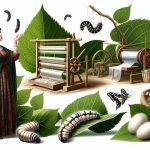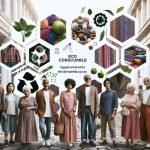Are you aware of the hidden truth behind sustainable fabrics? Discover the dark side of silk production.
Unethical practices, including exploitation of workers, cruelty to silkworms, and environmental damage, are all part of the industry. Child labor is also prevalent.
But fear not, there are ethical alternatives to support. Dive into the world of unethical silk and learn how to make conscious fabric choices that align with your values.
Table of Contents
Silk Workers: Exploitation and Labor Rights
If you care about ethical fashion, you need to know that silk workers often face exploitation and violations of their labor rights. The issue of silk worker wages and labor conditions is a pressing concern in the fashion industry. Silk production involves a labor-intensive process that requires skilled workers to carefully extract silk threads from silkworm cocoons. However, despite the high demand for silk and the luxurious image associated with the fabric, many silk workers are subjected to unjust working conditions and receive meager wages.
In many silk-producing countries, such as China and India, workers endure long hours of labor, often in hazardous environments. They’re frequently paid low wages that don’t reflect the value of their work or the high price of silk in the market. Additionally, silk workers often face workplace hazards, such as exposure to harmful chemicals and lack of safety precautions. These conditions not only compromise the workers’ well-being but also violate their basic labor rights.
Improving the wages and labor conditions of silk workers is crucial for promoting ethical fashion. Brands and consumers must advocate for fair trade practices and support initiatives that ensure decent working conditions and fair compensation for silk workers. By demanding transparency and accountability in the silk industry, we can contribute to a more sustainable and ethical fashion system.
Silkworm Cruelty: The Dark Reality of Sericulture
Silkworms endure cruel treatment throughout the process of sericulture, raising serious ethical concerns in the production of silk. The sericulture industry, which is responsible for cultivating silkworms and harvesting their silk, often overlooks the welfare of these creatures, prioritizing profit over animal rights.
Here are some key points to consider:
-
Forced labor: Silkworms are kept in cramped conditions, confined to small trays or boxes, and prevented from moving freely. This restricted environment is necessary to control the silk production process, but it leads to immense suffering for the silkworms.
-
Starvation: To obtain the highest quality silk, the silkworms are often starved before they begin spinning their cocoons. This deprivation weakens their immune systems and further compromises their well-being.
-
Killing of silkworms: In order to extract the silk threads, the silkworms are often killed inside their cocoons. This prevents them from completing their natural life cycle, causing unnecessary harm and death.
The sericulture industry must address these ethical concerns and find alternative methods for silk production that prioritize the well-being and rights of silkworms. By promoting cruelty-free silk production, we can create a more sustainable and compassionate fashion industry.
Environmental Impact: Silk Production’s Hidden Toll
Now let’s delve into the hidden toll of silk production on the environment.
Silk manufacturing processes, although often seen as sustainable, can have a significant impact on the environment, particularly in terms of chemical pollution. In order to obtain silk, cocoons are typically boiled in hot water to kill the silkworms inside. This process, known as sericulture, requires large amounts of water and energy. Additionally, chemicals such as bleach and detergents are often used to remove the natural gum from the silk fibers, further contributing to environmental pollution. These chemicals can contaminate water sources and harm aquatic ecosystems.
Furthermore, the dyeing and finishing stages of silk production also contribute to chemical pollution. Synthetic dyes are frequently used, many of which contain toxic substances that are harmful to both the environment and human health. These dyes can leach into water bodies during the dyeing process, leading to water pollution and the destruction of aquatic habitats.
To mitigate the environmental impact of silk production, it’s crucial to adopt more sustainable practices. This can include implementing cleaner and more efficient manufacturing processes, reducing water and energy consumption, and using natural and biodegradable dyes. By prioritizing environmental stewardship and embracing eco-friendly alternatives, the silk industry can work towards a more sustainable and ethical future.
Child Labor: Uncovering the Truth Behind Silk
Many children are forced into labor in the silk industry, revealing the dark truth behind the production of this supposedly sustainable fabric. It’s a heartbreaking reality that child labor continues to persist in the production of silk, despite the industry’s claims of sustainability. Here are some important facts and insights into the issue:
-
Child labor statistics: According to a report by the International Labor Organization (ILO), approximately 152 million children worldwide are engaged in child labor, with a significant number being exploited in the textile and garment industries. While specific data on child labor in the silk industry is limited, it’s known that silk production heavily relies on manual labor, making it vulnerable to exploitation.
-
Silk industry regulations: Although there are international conventions and national laws in place to combat child labor, the enforcement and regulation of these laws remain inadequate in many silk-producing countries. Weak labor inspection systems and corrupt practices often allow unethical practices to persist, perpetuating the cycle of child labor.
-
The need for transparency and accountability: To address the issue of child labor in the silk industry, there’s a pressing need for increased transparency in supply chains. Consumers and companies should demand greater accountability from silk producers, ensuring that ethical sourcing practices are followed and child labor is eradicated.
It is our collective responsibility to shed light on the dark truth behind silk production and work towards a more sustainable and ethical industry.
Alternatives to Unethical Silk: Ethical Fabric Choices
By exploring ethical fabric choices, you can make a conscious decision to move away from the dark reality of child labor in silk production. Fortunately, there are sustainable alternatives and vegan fabrics that can be used as ethical alternatives to silk.
One such alternative is organic cotton. It’s grown without the use of harmful pesticides and chemical fertilizers, making it a more sustainable choice for fabric. Organic cotton is also free from the cruelty associated with silk production, making it a compassionate option for those who are concerned about animal welfare.
Another ethical fabric choice is hemp. Hemp is a versatile and eco-friendly material that requires minimal water and no pesticides to grow. It’s also a highly durable fabric, making it a great choice for sustainable fashion.
For those who prefer vegan fabrics, there are options like bamboo. Bamboo fabric is made from the pulp of bamboo plants and has a soft and luxurious feel. It’s also a highly renewable resource, as bamboo grows quickly and requires little water to thrive.
Frequently Asked Questions
How Are Silk Workers Exploited and What Are Their Labor Rights?
You’re wondering about the exploitation of silk workers and their labor rights violations. Silk workers are often exploited, with their labor rights violated. Their working conditions and wages are often unfair and unjust.
What Is the Dark Reality of Sericulture and How Does It Involve Silkworm Cruelty?
Silkworm farming has a dark reality when it comes to sericulture. The process involves silkworm cruelty, which is a harsh truth behind unethical silk production. It’s important to be aware and support ethical practices.
What Is the Hidden Toll on the Environment Caused by Silk Production?
The hidden environmental impact of silk production raises sustainability concerns. It’s important to understand the toll it takes on ecosystems and resources. Ethical choices can help mitigate these effects and promote a more sustainable fashion industry.
What Is the Truth About Child Labor in the Silk Industry?
Child labor in the silk industry is a concerning issue. Government regulations aim to prevent it, but the reality is still alarming. Child labor statistics reveal the harsh truth that needs attention and action.
What Are Some Ethical Fabric Choices That Serve as Alternatives to Unethical Silk?
You can make sustainable choices by opting for eco-friendly fabrics as alternatives to unethical silk. Look for options like organic cotton, hemp, bamboo, or Tencel, which are all better for the environment.
- How Does Ring Spun Cotton Affect Garment Fit and Shape Retention? - August 13, 2024
- What Are the Challenges in Producing Ring Spun Cotton? - August 13, 2024
- Is Ring Spun Cotton Suitable for Plus-Size Clothing? - August 13, 2024





